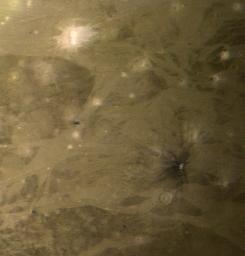
|
Ganymede’s Equatorial Region
- Click the image above for a larger view
- Full-Res JPEG (860 x 901) (91.2 kB)
- Full-Res TIFF (860 x 901) (1.5 MB)
Caption:
GANYMEDE COLOR PHOTOS: This color picture as acquired by Voyager 1 during its approach to Ganymede on Monday afternoon (the 5th of March). At ranges between about 230 to 250 thousand km. The images show detail on the surface with a resolution of four and a half km. This picture is south of PIA01516 (P21262) near the equator of Ganymede, and has relatively subdued colors in the visible part of the spectrum (later, scientists will analyze Voyager pictures taken in UV). The most striking features are the bright ray craters which have a distinctly "bluer" color appearing white against the redder background. Ganymede's surface is known to contain large amounts of surface ice and it appears that these relatively young craters have spread bright fresh ice materials over the surface. Likewise, the lighter color and reflectivity of the grooved areas suggest that here, too, there is cleaner ice. We see ray craters with all sizes of ray patterns, ranging from extensive systems, down to craters which have only faint remnants of bright ejecta patterns. This variation suggests that, as on the Moon, there are processes which act to darken ray material, probably "gardening" by micrometeoroid impact.
Background Info:
JPL manages and controls the Voyager project for NASA's Office of Space Science.
Cataloging Keywords:
| Name | Value | Additional Values |
|---|---|---|
| Target | Ganymede | |
| System | Jupiter | |
| Target Type | Satellite | |
| Mission | Voyager | |
| Instrument Host | Cassini Orbiter | Voyager 1 |
| Host Type | Orbiter | Flyby Spacecraft |
| Instrument | Imaging Science Subsystem (ISS) | |
| Detector | ||
| Extra Keywords | Color, Crater, Impact, Moon, Ultraviolet | |
| Acquisition Date | ||
| Release Date | 1999-03-13 | |
| Date in Caption | ||
| Image Credit | NASA/JPL | |
| Source | photojournal.jpl.nasa.gov/catalog/PIA01517 | |
| Identifier | PIA01517 | |
